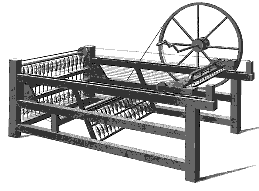

|
After the Norman Conquest in 1066, Britain's main economy was in the export wool, and the European textile markets were heavily dependent upon the supply of raw English wool, which made trading in wool a highly profitable means of making money. Sheep farmers and small cottagers scattered throughout the country all contributed towards the overall total, for it was very much a cottage industry. The Wool merchants of Devon very quickly became wealthy; they bought their fleeces from the small farmers or from middlemen employed by the farmers. Their wool collectors journeyed around all the local farms collecting the fleeces, and loading them onto a string of laden packhorses, before finally taking their loads to wool markets. These Markets were held on specific dates at strategic towns where the local merchants would meet with merchant traders from across Europe, especially from France, Flanders or Italy. Whilst there are some records showing payment for finished cloth being made in the early 1200s, there was no real significant export of finished fabric until after 1300. The Exeter wool market sold over £10,000 of yarn and wool in the year of 1536, but by 1540 this figure had fallen to £5000. However at the same time the weekly figure for wool cloth now exceeded it, with £100,000 worth of serge each week leaving Exeter Staple. Successive monarchs taxed the wool trade, especially when they had special need for additional revenue, such as in times of war. A system gradually evolved by which wool could only exported through a limited number of specified towns known as the staple towns, these being determined by Royal Ordnance. Eventually there was only one such staple in continental Europe, and that was Calais. The merchants of the Staple in Calais therefore had a monopoly over the sale of all English wool to Europe. This had an unintended consequence in that it drove up the price of wool, which in turn drove up the prices of the cloth manufactured in Europe. Prior to this England had been a net importer of woollen fabric, but now that European wool was more expensive, it now became worthwhile to manufacture cloth at home. The staple monopoly in Calais destroyed itself prior to the fall of the town to the French in 1558, and England became the greatest cloth producing country in the world. In the 18th Century, Exeter was the leading wool market in England. By the 17th Century the importance of the woollen industry to this country was significant, and Devon was famed for producing several types of woollen fabric or cloth. One such, described as the 'best known of all English fabrics' was Broadcloth, and was renowned both in Europe and America, and remained fashionable for over 500 years, it is strange therefore, that so little evidence of this importance now remains. Whilst on a visit to Exeter in 1698, Celia Fiennes wrote that: the whole town and surrounding countryside for at least 20 miles round is employed in spinning, weaving, dressing and scouring, fulling and drying of serge's, it turns the most money in a weeke of anything in England.
The native breeds of sheep were the Exmoor, the Dartmoor, and also the Old Devonshire dim-faced nott sheep, with the Exmoor, the Dartmoor being the most common, whilst the Dorsetshire breed prevails along the county border with Dorset. The wool crop is the main purpose for those whose flocks are to be found in the forests or on the moors. It is an interesting fact that the rot has never yet been known to have originated with sheep constantly pasturing upon Dartmoor or Exmoor. In order to promote the wool trade, King Charles II passed an act of parliament in which it was an offence for someone to be buried without being wrapped in a woollen cloth, and the fine imposed was £5. Thus "wearing a linsey-woolsey gown" became common parlance for death. The act was not repealed until 1814. The production of woollen cloth changed little until the eighteenth century. Fleeces were first washed then sorted, followed by carding and combing to separate the lengths of the fibres (staple). The wool was then spun by distaff and spindle, the process being speeded up in the thirteenth century by the invention of the spinning wheel. Medieval looms were improved in 1773 by the introduction of the flying shuttle, although weavers were slow to adopt this innovation in parts of the West Country. To thicken and clean the cloth it was 'fulled' by being soaked in water and fuller's earth or potash. It was originally trampled on by 'Walkers', but in the twelfth century the water mills provided the power to drive hammers to beat the cloth. The cloth was then spread out on tenterhooks to dry. Dyeing might follow at this stage, using woad or madder for the more usual colours of blue and brown, and fixed by a mordant, usually of imported alum. 'Teasing' to raise the nap and then shearing finally finished the cloth. Previous Last Edited 03/07/2006 Copyright © 2000-2006 Witheridge Unless otherwise indicated on the page in question, the photographic images reproduced on this site belong to the Witheridge Archives, and, as such may not be reproduced for commercial purposes without written permission. However, you are welcome to use any of the photographs belonging to the archive for personal and/or non-commercial use. Any material shown as not being owned by the archive may not be reproduced in any form without first receiving written permission from the owner of the material in question. |


